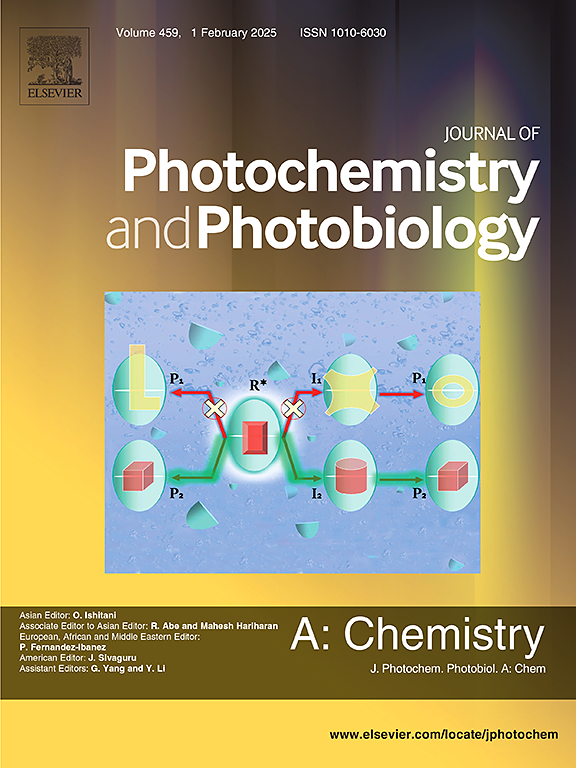Multiphase BiVO4 for environmental applications
IF 4.1
3区 化学
Q2 CHEMISTRY, PHYSICAL
Journal of Photochemistry and Photobiology A-chemistry
Pub Date : 2025-04-05
DOI:10.1016/j.jphotochem.2025.116421
引用次数: 0
Abstract
The synthesis of BiVO4 multiphase photocatalysts was approached using a method and conditions designed to produce tetragonal-rich and monoclinic-rich materials with varying morphologies. The results of the SEM analysis indicated that a pH range of 3 to 7 during the hydrothermal process facilitates the formation of spherical particles with a diameter of 3.3–3.4 μm, comprising 6–7 nm crystals. Conversely, a pH value below 3 or the addition of CTAB as a surfactant resulted in the crystallization of nanocrystals with a size range of 0.5–5.0 μm, exhibiting well-defined facets. X-ray diffraction (XRD) analysis demonstrated that the former are predominantly tetragonal in variety, with a minor component of monoclinic. In the case of the latter, XRD in conjunction with electronic property analysis enabled the detection of the tetragonal variety in quantities below the detection threshold of the XRD, accompanied by the monoclinic variety. The monoclinic-rich BiVO4 exhibited notable discrepancies in its electrokinetic parameters, including hydrothermal diameter, in comparison to the tetragonal-rich samples. Moreover, PL studies revealed that the monoclinic-rich samples exhibited up to a 100-fold reduction in emissions, with a decay time up to six times longer which is attributed to the presence of point defects. Monoclinic-rich samples also demonstrate enhanced activity with regard to the degradation of Rhodamine B and basic Fuchsin. In particular, the former exhibits superior performance, achieving results that are several times more effective. Radical scavenging tests showed that •OH radicals were responsible for degrading bF and RhB dyes. The enhanced photocatalytic properties of monoclinic-rich samples were ascribed to augmented absorption, restricted recombination of charge carriers, and the existence of point defects.

多相BiVO4用于环境应用
研究了BiVO4多相光催化剂的合成方法和条件,制备了具有不同形貌的富四方晶和富单斜晶材料。SEM分析结果表明,水热过程中pH值在3 ~ 7范围内有利于形成直径为3.3 ~ 3.4 μm、晶体长度为6 ~ 7 nm的球形颗粒。相反,当pH值低于3或添加CTAB作为表面活性剂时,纳米晶体的结晶尺寸范围为0.5 ~ 5.0 μm,具有清晰的晶面。x射线衍射(XRD)分析表明,前者以四角形为主,单斜形成分较少。在后者的情况下,XRD结合电子性质分析,可以检测到数量低于XRD检测阈值的四方型,并伴有单斜型。单斜富BiVO4的电动力学参数(包括热液直径)与四边形富BiVO4的电动力学参数存在显著差异。此外,PL研究表明,单斜富样品的排放量减少了100倍,衰变时间延长了6倍,这是由于点缺陷的存在。单斜丰富的样品也表现出增强的活性,关于罗丹明B和碱性品红的降解。特别是,前者表现出优越的性能,取得的结果是几倍的有效。自由基清除试验表明,•OH自由基对bF和RhB染料有降解作用。单斜富集样品的光催化性能增强归因于吸收增强、载流子重组受限以及点缺陷的存在。
本文章由计算机程序翻译,如有差异,请以英文原文为准。
求助全文
约1分钟内获得全文
求助全文
来源期刊
CiteScore
7.90
自引率
7.00%
发文量
580
审稿时长
48 days
期刊介绍:
JPPA publishes the results of fundamental studies on all aspects of chemical phenomena induced by interactions between light and molecules/matter of all kinds.
All systems capable of being described at the molecular or integrated multimolecular level are appropriate for the journal. This includes all molecular chemical species as well as biomolecular, supramolecular, polymer and other macromolecular systems, as well as solid state photochemistry. In addition, the journal publishes studies of semiconductor and other photoactive organic and inorganic materials, photocatalysis (organic, inorganic, supramolecular and superconductor).
The scope includes condensed and gas phase photochemistry, as well as synchrotron radiation chemistry. A broad range of processes and techniques in photochemistry are covered such as light induced energy, electron and proton transfer; nonlinear photochemical behavior; mechanistic investigation of photochemical reactions and identification of the products of photochemical reactions; quantum yield determinations and measurements of rate constants for primary and secondary photochemical processes; steady-state and time-resolved emission, ultrafast spectroscopic methods, single molecule spectroscopy, time resolved X-ray diffraction, luminescence microscopy, and scattering spectroscopy applied to photochemistry. Papers in emerging and applied areas such as luminescent sensors, electroluminescence, solar energy conversion, atmospheric photochemistry, environmental remediation, and related photocatalytic chemistry are also welcome.

 求助内容:
求助内容: 应助结果提醒方式:
应助结果提醒方式:


